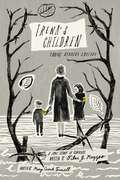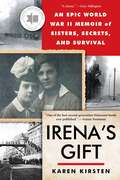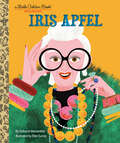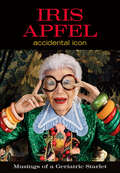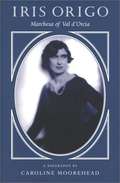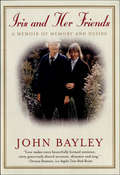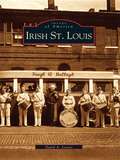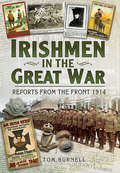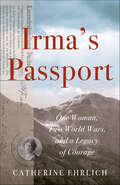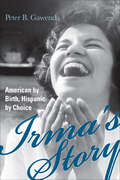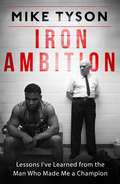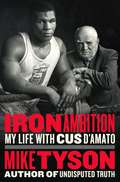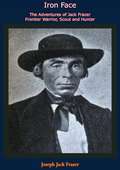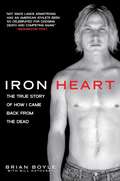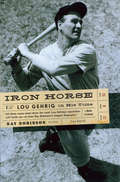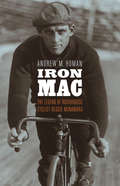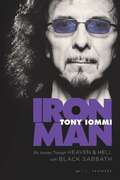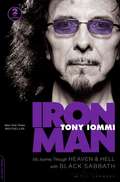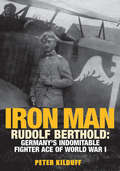- Table View
- List View
Irena's Children: Young Readers Edition; A True Story of Courage
by Tilar J. Mazzeo Mary Cronk FarrellFrom New York Times bestselling author Tilar Mazzeo comes the extraordinary and long forgotten story of Irena Sendler--the "female Oskar Schindler"--who took staggering risks to save 2,500 children from death and deportation in Nazi-occupied Poland during World War II--now adapted for a younger audience.Irena Sendler was a young Polish woman living in Warsaw during World War II with an incredible story of survival and selflessness. And she's been long forgotten by history. Until now. This young readers edition of Irena's Children tells Irena's unbelievable story set during one of the worst times in modern history. With guts of steel and unfaltering bravery, Irena smuggled thousands of children out of the walled Jewish ghetto in toolboxes and coffins, snuck them under overcoats at checkpoints, and slipped them through the dank sewers and into secret passages that led to abandoned buildings, where she convinced her friends and underground resistance network to hide them. In this heroic tale of survival and resilience in the face of impossible odds, Tilar Mazzeo and adapter Mary Cronk Farrell share the true story of this bold and brave woman, overlooked by history, who risked her life to save innocent children from the horrors of the Holocaust.
Irena's Gift: An Epic WWII Memoir of Sisters, Secrets, and Survival
by Karen KirstenA National Jewish Book Awards Finalist WINNER, ZIBBY AWARDS FOR BEST FAMILY DRAMA & BEST STORY OF OVERCOMING Weaving mystery, history and memoir, Irena&’s Gift is the captivating account of one woman&’s personal quest to uncover the unspoken and give voice to her family&’s secret war-torn history. From the glittering concert halls of interbellum Warsaw to the vermin-infested prison where an SS officer is convinced to save a Jewish child&’s life, to the author&’s upbringing in a Christian home, this is a story of resilience, sacrifice, Jewish identity, intergenerational trauma, and the secrets we keep to protect ourselves and those we love. For readers of When Time Stopped by Ariana Neumann, I Want You to Know We&’re Still Here by Esther Safran Foer, and House of Glass by Hadley Freeman."Irena&’s Gift interrogates the messy complexity of family, both its tenderness and nurture but also its corrosive anger and rejection.&” —GERALDINE BROOKS, New York Times bestselling author and Pulitzer Prize winner In 1942, in German-occupied Poland, a Jewish baby girl was smuggled out of the Warsaw ghetto in a backpack. That baby, Joasia, knew nothing about this extraordinary event until she was thirty-two, when a letter arrived from a stranger. She also learned that the parents who raised her were actually her aunt and uncle. Joasia kept this knowledge hidden from her own daughter, Karen—until an innocent question unexpectedly revealed the truth. Determined to understand the generational trauma that cloaked her family in silence, her own origins, and to help heal her mother&’s pain, Karen set out to unearth decades of secrets and piece together a hidden history—from the glittering days of pre-war Poland to the little-known Radom Prison, where of 500 resistance members tortured, only 10 survived, her grandfather the only known Jewish one. There, Karen finds answers, yet not easy ones. As she exposes her family&’s saga of love and betrayal, countless brushes with death, precarious hiding places, and the astounding negotiation with an SS officer who saved her mother&’s life, Karen must reconcile the complicated, multi-faceted truths behind human behavior. Irena&’s Gift weaves together a mystery, history, and memoir to tell a story of sacrifice, impossible choices, impossible odds, and the way trauma reverberates throughout generations. Yet it is also a story of resilience and bravery, revealing how love and hope, too, can not only prevail through the worst imaginable circumstances, but resonate through time.
Iris Apfel: A Little Golden Book Biography (Little Golden Book)
by Deborah BlumenthalHelp your little one dream big with a Little Golden Book biography about Iris Apfel, the style icon and beloved tastemaker known for her eclectic eyewear! Little Golden Book biographies are the perfect introduction to nonfiction for preschoolers.This Little Golden Book about Iris Apfel—businessperson, interior designer, and fashion icon who has captivated the world with her colorful and unique style—is an inspiring read-aloud for young children.Look for more Little Golden Book biographies: • Misty Copeland • Frida Kahlo • Bob Ross • Queen Elizabeth II • Harriet Tubman
Iris Apfel: Accidental Icon
by Iris ApfelFrom the fashion icon, “a joyous, colorful collection of photographs; drawings; reflections; and personal mottos on marriage, business, fame and style” (Boca Raton Observer).The late great Iris Apfel was a woman who transcended time and trends—one of the most original and dynamic personalities in the worlds of fashion, textiles, and interior design. Written a few years before her passing at age 102, this is a lavishly illustrated memoir in which she shares her musings, anecdotes, and incomparable wisdom.As the cofounder with her husband of Old World Weavers, an international textile manufacturing company that specialized in reproducing antique fabrics, she served a prestigious clientele including Greta Garbo, Estee Lauder, Montgomery Clift, and Joan Rivers. She also acted as a restoration consultant and replicated fabric for the White House over nine presidential administrations. Iris’s worldwide travels and devotion to flea markets inspired her work and fueled her passion for collecting fashion and accessories. In 2005, she was the first living person who was not a designer to have her clothing and accessories exhibited at the Costume Institute at the Metropolitan Museum of Art, a blockbuster show that catapulted her to fame and a career as a model, muse, and collaborator for renowned brands from Citroen to Tag Heuer. In 2015, acclaimed director Albert Maysles released Iris, his Emmy Award-nominated documentary, to a global audience.This celebratory volume captures her unique joie de vivre and features 180 full-color and black-and-white photos and illustrations—presented in the same improvisational, multifaceted style that made Iris a much-loved legend. “It’s hard to resist this self-proclaimed ‘geriatric starlet.’ With her owlish glasses, loud prints and necklaces upon necklaces, even in her 90s, Apfel is a fashion icon who combines a memoir with photos of the vibrant contents of her closets.” —The New York Times Book Review
Iris Origo: Marchesa of Val d'Orcia
by Caroline MooreheadIris Origo was one of those rare characters who, despite being born with a platinum spoon in her mouth, went on to accomplish great things. In Origo's case, she managed to add light & color to everything she touched & left for posterity a legacy of work, biography, autobiography, & literary criticism that have become recognized as classics of their kind.
Iris and Her Friends: A Memoir of Memory and Desire
by John BayleyA timeless work that will bring healing to anyone dealing with the loss of a loved one. John Bayley began writing Iris and Her Friends, a companion to the New York Times bestseller Elegy for Iris, late at night while his wife, the beloved novelist Iris Murdoch, succumbed to Alzheimer's Disease. As Iris was losing her memory, Bayley was flooded with vivid recollections of his own. In lyrical reverie, Bayley recreates the unforgettable scenes of his youth, from his birth to a civil servant in colonial India to his long romance with Iris and its heartbreaking end. This is the transcendent work of a brilliant man, whose examination of the tragedies and joys of his own life will give readers great healing insight. John Bayley's Iris and Her Friends is nothing less than a classic of true love and sorrow. "Love makes every beautifully formed sentence, every generously shared moment, shimmer and sing."--Donna Seaman, Los Angeles Times Book Review
Irish Rogues, Rascals and Scoundrels
by Padraic O'FarrellFrom the back cover, "A rogue can be a dishonest or unprincipled person but more often he is a 'likable rogue' i.e. a rascal and a scoundrel tolerated for his fun and his penchant for taking the harm out of his indiscretions by some redeeming act. Our history has thrown up a variety of rogues and scoundrels. The likable rogue, the impish rascal, the schemer, the hypocritical plamás and the downright cad--each genre is represented in Padraic O'Farrell's collection which includes the Sham Squire, Lord Haw-Haw, Alfie Byrne, Jack Doyle, 'Kruger', Madams of Monto and other fascinating characters." Born in Co. Kildare in 1932, Padraic O'Farrell lives with his family in Mullingar, Co. Westmeath. He has published 23 books, including Proverbs and Sayings: Gems of Irish Wisdom and How the Irish Speak English. He has scripted revues for professionals and amateurs and writes humorous features and theatre columns for various publications including The Irish Times, Theatre Ireland, Irish Stage and Screen and Etudes Irland. Contains three pages of notes.
Irish Saints (Vision Series #63)
by Robert T. Reilly[from dust jacket flaps:] Vision Books * Winner of The Thomas More Assn'n Medal The history of Ireland, like that of many lands, is studded with the names of canonized saints and other good people who have proven that sanctity spans all times. In telling the stories of Patrick and Brigid, the navigator Brendan, missionaries Columcille and Columban, martyrs Laurence O'Toole and Blessed Oliver Plunkett, Mother McAuley and her Sisters of Mercy, the saintly layman Matt Talbot, Father Theobald Mathew, and Bishop Galvin who so long resisted the Communist onslaught in China, Robert Reilly illumines Ireland's history, her people, and the land itself. The Irish saints whose stories are told in this book are "saints" in the broad religious sense. Some have been canonized by the Church; others, though not formally saints, are nonetheless saintly. This rich collection of biographies is for Catholic youngsters from 9 to 15. THE AUTHOR Robert T. Reilly is Director for Special Resources at The Creighton University in Omaha, Nebraska. He has an M.A. from Boston University and has taught Irish Literature, of which he has a large collection. Among his previous books are Red Hugh, Prince of Donegal, Massacre at Oak Hollow, and Rebels in the Shadows. Mr. Reilly is the father of nine children. [He has survived captivity by the Germans and held as a prisoner of war.]
Irish St. Louis (Images of America)
by David A. LossosIt's quite unlikely that Pierre Laclede and Auguste Chouteau could have comprehended the scope of their undertaking in 1764 when they laid out the settlement on the western banks of the Mississippi that was to become the metropolis of St. Louis. Founded by the French, governed by the Spanish, and heavily populated by the English and Germans, the role that the Irish had in making St. Louis what it is today is often overlooked. The Irish are steeped in tradition, and that trait did not leave the Irish immigrants when they arrived in St. Louis and called this place home. Like many other cities in America, the heritage of Ireland is alive and well in St. Louis. This book visually captures their Irish spirit, and portrays a few of the Irish "movers and shakers" alongside the "Irish commoner" in their new and challenging lives here in St. Louis.
Irishmen in the Great War: Reports from the Front 1914
by Tom BurnellTwenty-seven Irish newspapers for the period covering the Great War have been trawled through to deliver the amazing stories of those years which changed the world for ever. These are the accounts of local men at the front; of torpedoed ships; drunken wives; final letters and requests from the trenches. Also eye-witness accounts of the slaughter as it was happening; battle reports from officers serving in Irish regiments; quirky snippets; chaplains' sympathetic letters; P.o.W reports of conditions and war poetry. Here are the tales of the Leinster's, Munster's, Connaught's and Dublin Fusiliers serving in the Ulster Division, 10th and 16th Irish Divisions. We read of medical breakthroughs, paranormal occurrences and miraculous escapes from death. After the Irish Rebellion of April, 1916, these type of articles and casualty lists dwindled to very few as Irish hearts became divided.As featured on Tipp FM and in the Tipperary Star and Dungarvan Observer.
Irma's Passport: One Woman, Two World Wars, and a Legacy of Courage
by Catherine EhrlichIn this gripping family tale, Catherine Ehrlich explores her Austrian grandparents’ influential lives at the crossroads of German and Jewish national movements. Weaving her grandmother Irma’s spellbinding memoirs into her narrative, she profiles a charismatic woman who confronts history with courage and rebuilds lives—for herself and Europe’s dispossessed. Starting out in Bohemia’s picturesque countryside, Irma studies languages in Prague alongside Kafka and Einstein—and so joins Europe’s intelligentsia. Tension builds as World War I destroys that world, and Irma marries prominent Zionist, Jakob Ehrlich, bold advocate for Vienna’s 180,000 Jews. Irma’s direct words detail the weeks after Hitler’s arrival when Adolf Eichmann himself appears to liberate Irma and her son from Vienna. Irma’s stunning turnaround in London unfolds amidst a dazzling cohort of luminaries—Chaim and Vera Weizmann, and Viscountess Beatrice Samuel among them. Irma finds her voice as an activist, saving lives and resettling refugees, and ultimately moves on to New York where her work resumes among high-profile friends like Catskills hostess Jennie Grossinger. Along the way, Ehrlich queries her family’s fate: what was behind Eichmann's twisted role in her grandparents’ lives? How was Irma able to focus outwardly when her own life was in crisis? Part intimate memoir, part historical thriller, Irma’s Passport is an inspiring true story about remarkable women whose unsung courage restored the world we know. This is a book for fans of Edmund de Waal, Erik Larson, and Alexander Wolff.
Irma's Story: American by Birth, Hispanic by Choice (Irma's Story Ser.)
by Peter B. Gawenda“The compelling true story of the impassioned love shared between a south Texas woman of Hispanic descent and a German military officer.” —Yvonne Freeman, PhD, professor, Department of Language, Literacy, and Intercultural Studies at the University of Texas at BrownsvilleAfter World War II, Peter, a handsome German pilot, met Irma, a beautiful Texan woman of Hispanic descent. It was love at first sight. Their meeting had been prophesized—for Irma by her grandmother and for Peter by a palm reader—and together the couple would create an extraordinary life. Irma’s Story: American by Birth, Hispanic by Choice chronicles Irma’s life and the experiences of the “Texan Gawendas” during their tenure in the German military in Europe and the United States. Though Irma, accepted as an American while in Europe, faced discrimination in her home country and contended with the challenges of being a military wife, Peter’s love and companionship remained constant.In his second book, Peter B. Gawenda, author of The Children’s War, offers readers an insider’s view of the joys that the marriage of two people—from two completely different worlds—can bring. Presenting the dynamics of racial issues against the backdrop of military life, the captivating story of Irma Lozano de Gawenda depicts a fearless, fiercely loyal woman willing to do anything for her family.Written with a passion that has spanned five decades, Irma’s Story celebrates the strength of a once-in-a-lifetime love.“He thrills [readers] again, turning to his narrative gifts and rich trove of memories to tell another story with universal appeal—the power of enduring love.” —Robert Becker, veteran journalist and former international wire news editor, Houston Chronicle
Irma: The Education of a Mother's Son
by Terry McDonellA son’s lessons from his single mother—a twenty five year old widow who took control of her life, defied expectations and raised him into a manhood of his own—from the author of the acclaimed The Accidental Life.As a child, Terry McDonell imagined epic stories about his father, a fighter pilot who died in World War II. But, as he discovers in this dazzling memoir, the real hero in his life was his mother, Irma, who moved with him to California hoping for a new life and raised him through difficult times.Like most headstrong boys growing up in mid-century America, McDonell took his mother for granted, never giving her life much thought. He was bright, cocky, and determined to make his own way, separate from her and from his complicated roots. But as he matured, built a career, married, divorced, remarried, and raised his own sons, McDonell came to see that Irma had lived her life in a way that allowed him to discover what he wanted his own life to be. The person he was would be forever tied to Irma’s courage and wisdom and love. From his recollections—a series of colorful, deeply personal, sometimes funny, stunningly composed vignettes—an intriguing and poignant portrait emerges.Irma is the story of a formidable woman who built the life she wanted as she raised her son to be the kind of man and father he had longed for but never knew.
Iron Ambition: Lessons I've Learned from the Man Who Made Me a Champion
by Larry Sloman Mike TysonThe story of the relationship between the most devastating heavyweight boxer in history and the mentor who made him.When legendary boxing trainer Cus D'Amato saw thirteen-year-old Mike Tyson spar in the ring, he proclaimed 'That's the heavyweight champion of the world'. D'Amato played a huge role in Tyson's formative years, legally adopting him at age sixteen, and shaping him both physically and mentally after years of living in poverty. He would train the young boxer for several years, dying just months before Tyson became the youngest heavyweight champion in history.In Iron Ambition, Tyson shares the life lessons that D'Amato passed down to him and reflects on how the trainer's words of wisdom continue to resonate with him outside the ring. The book also chronicles Cus's courageous fight against the mobsters who controlled boxing, revealing more than we've ever know about this singular cultural figure.
Iron Ambition: My Life with Cus D'Amato
by Larry Sloman Mike Tyson"[Iron Ambition] spells out D'Amato's techniques for building a champion from scratch." – Wall Street JournalFrom the former heavyweight champion and New York Times–bestselling author comes a powerful look at the life and leadership lessons of Cus D’Amato, the legendary boxing trainer and Mike Tyson’s surrogate father. When Cus D’Amato first saw thirteen-year-old Mike Tyson spar in the ring, he proclaimed, “That’s the heavyweight champion of the world.” D’Amato, who had previously managed the careers of world champions Floyd Patterson and José Torres, would go on to train the young Tyson and raise him as a son. D'Amato died a year before Tyson became the youngest heavyweight champion in history. In Tyson’s bestselling memoir Undisputed Truth, he recounted the role D’Amato played in his formative years, adopting him at age sixteen after his mother died and shaping him both physically and mentally after Tyson had spent years living in fear and poverty. In Iron Ambition, Tyson elaborates on the life lessons that D’Amato passed down to him, and reflects on how the trainer’s words of wisdom continue to resonate with him outside the ring. The book also chronicles Cus’s courageous fight against the mobsters who controlled boxing, revealing more than we’ve ever known about this singular cultural figure.
Iron Coffins: A Personal Account of the German U-Boat Battles of World War II
by Herbert A. WernerFrom the Foreword by Captain Edward L. Beach, U.S. Navy (Ret.) "Madness!" cries Werner, and it was madness. But there were heroes, too, who deserve admiration even though their cause was wrong.... No one can fault the warrior who believes in his country so strongly that he dies for it.... Because their leaders told them so, they believed that if they fought desperately, they might save their country from the disaster plainly grinding in from every side. They expected death, and most of them found it, but they fought hard all the same, and they carpeted the ocean floor with their bodies.
Iron Face: The Adventures of Jack Frazer Frontier Warrior, Scout and Hunter
by Joseph Jack Frazer Henry Hastings SibleyWritten in the 1850’s by Henry Hastings Sibley, recorded first hand from Iron Face, a half-breed Sioux warrior and scout. Frazer, also was a half-breed born and raised in a Sioux village. Includes information on the Black Hawk War and the Minnesota Massacre. Vestal says, “We are lucky, I think, to have this story in any form. Its chief service is a tool to help us understand a kind of life now gone forever.” Stanley Vestal states that this volume presents a close-up picture of the Indians. Jack Frazer was a half-breed whose Sioux name was Iron Face. “There is no lace or perfume in theis book, no gilding of the aboriginal lily . . .”With Introduction And Notes By Theodore C. Blegen And Sara A. Davidson.
Iron Heart: The True Story of How I Came Back from the Dead
by Bill Katovsky Brian BoyleIt was a horrific car crash. On the way home from swim practice, eighteen-year old Brian Boyle’s future changed in an instant when a dump truck plowed into his Camaro. He was airlifted to a shock-trauma hospital. He had lost sixty percent of his blood, his heart had moved across his chest, and his organs and pelvis were pulverized. He was placed in a medically-induced coma. When Brian finally emerged from the coma two months later, he had no memory of the accident. He could see and hear, but not move or talk. Unable to communicate to his doctors, nurses, or frantic parents, he heard words like "vegetable” and "nursing home.” If he lived, doctors predicted he might not be able to walk again, and certainly not swim. Then, miraculously, Brian clawed his way back to the living. First blinking his eyelids, then squeezing a hand, then smiling, he gradually emerged from his locked-in state. The former swimmer and bodybuilder had lost one hundred pounds. Iron Heart is the first-person account of his ordeal and his miraculous comeback. With enormous fortitude he learned to walk, then run, and eventually, to swim. With his dream of competing in the Ironman Triathlon spurring him on, Brian defied all odds, and three-and-a-half years after his accident, crossed the finish line in Kona, Hawaii. Brian’s inspiring journey from coma to Kona is brought to life in this memoir.
Iron Horse: Lou Gehrig in His Time
by Ray Robinson"All these many years down the road, Lou Gehrig's reputation still holds up as does Ray Robinson's elegant biography." -Bob Costas Lou Gehrig will go down in history as one of the best ballplayers of all time; he was elected to the Hall of Fame and played in a record-setting 2,130 consecutive games. ALSknown today as "Lou Gehrig's Disease"robbed him of his physical skills at a relatively young age, and he died in 1941. Ray Robinson re-creates the life of this legendary ballplayer and also provides an insightful look at baseball, including all the great players of that era: Babe Ruth, Ty Cobb, Walter Johnson, and more. 16 photographs.
Iron Mac: The Legend of Roughhouse Cyclist Reggie McNamara
by Andrew M. HomanAt a time when cycling in the United States rivaled baseball as the nation’s most popular professional sport, along came Reggie McNamara, a farmer’s son from Australia. Within a month of his arrival in the United States in 1913, he had earned the moniker “Iron Man” for his high tolerance of pain and his remarkable ability to recover from seemingly catastrophic injury. The nickname proved justified. Not only was he tough, he was also one of the best and highest-paid athletes in the world. During his thirty-year career, McNamara won seventeen punishing six-day races along with an inestimable number of shorter distance races, including high-profile events on three different continents, peaking in 1926–27 at the age of thirty-nine. The fans, media, and his fellow professionals all idolized him as an example of the true grit needed to succeed in this grueling and dangerous sport. Late in his career, however, hard drinking and injuries took their toll, and McNamara became estranged from his wife and children. He fought back just as he always had on the race course, conquering his addiction to alcohol and becoming one of the earliest success stories of Alcoholics Anonymous. In this humorous and exciting biography of the original Iron Man, Andrew M. Homan pulls McNamara back into the spotlight, depicting a flawed but beloved man whose success in those unrelenting six-day races came at a price.
Iron Man
by Tony IommiIron Man chronicles the story of both pioneering guitarist Tony Iommi and legendary band Black Sabbath, dubbed "The Beatles of heavy metal" by Rolling Stone. Iron Man reveals the man behind the icon yet still captures Iommi's humor, intelligence, and warmth. He speaks honestly and unflinchingly about his rough-and-tumble childhood, the accident that almost ended his career, his failed marriages, personal tragedies, battles with addiction, band mates, famous friends, newfound daughter, and the ups and downs of his life as an artist.Everything associated with hard rock happened to Black Sabbath first: the drugs, the debauchery, the drinking, the dungeons, the pressure, the pain, the conquests, the company men, the contracts, the combustible drummer, the critics, the comebacks, the singers, the Stonehenge set, the music, the money, the madness, the metal.
Iron Man
by Tony IommiThe memoir of one of the great musicians of our time, Tony Iommi?Grammy-winning revolutionary guitarist, cofounding member of Black Sabbath, and architect of heavy metal
Iron Man: My Journey through Heaven and Hell with Black Sabbath
by Tony IommiTony Iommi, rock guitarist and Black Sabbath legend, invented the heavy metal sound that changed rock music forever . . . from working class Midlands roots, Tony Iommi's unique playing style - a result of a disfiguring hand injury he suffered working in a sheet metal factory - created a dark and gothic sound unlike anything that had been heard before, spawning generations of devoted fans. Black Sabbath went on to become a superband, and Iommi led the life of a rockstar to the fullest - with the scars from all the nights of wild excess to show for it. In Iron Man, Iommi goes on the record about Sabbath and tells his story: the life and adventures of one of rock's greatest heroes. 'Tony Iommi is the true father of Heavy Metal, a continuously creative genius riff-meister, and one of the world's great human beings' Brian May 'Without Tony, heavy metal wouldn't exist. He is the creator of heavy! Tony is a legend. He took rock and roll and turned it into heavy metal' Eddie van Halen 'Mr Iommi, aka . . . The riffmaster. It's all his fault I am where I am' James 'papa HET' Hetfield
Iron Man: Rudolf Berthold: Germany's Indomitable Fighter Ace of World War I
by Peter KilduffThis biography of a tenacious fighter pilot is &“a powerful story about a fascinating man who seemed to know no fear&” (Aerodrome). As one of the most successful German fighter pilots of World War I, Rudolf Berthold was victorious in forty-four aerial combats. He was also shot down or forced to land after six fights and survived crash landings in every case. Early in WWI, when only fighter pilots were awarded the Kingdom of Prussia&’s (and de facto, Imperial Germany&’s) highest bravery decoration, the Pour le Mérite, Berthold became the tenth recipient of the honor. Of that early cohort of air heroes, only Berthold and one other pilot survived the war. This book tells his remarkable story. Six weeks into the war, Berthold became the first airman in the 2nd Army area to be awarded an Iron Cross in recognition of his bravery and tenacity in combat. The symbolism of the award was appropriate. Described by one of his pilot protégés as &“an Iron Man—with an absolutely unbendable iron will,&” he was a dedicated patriot. And, after he became a fighter pilot, he demonstrated a fierce fighting spirit in many encounters with British and French adversaries. All of his aerial combats with other Pour le Mérite–awarded flyers are detailed in this book. Indeed, Berthold was so relentless in his approach to aerial combat that when badly wounded, on at least six occasions, he cut short his convalescent leave to return to flying with his comrades. The injuries included a hit to his right arm, which shattered the bone, rendering it useless—yet an undaunted Berthold taught himself to fly using his left. Peter Kilduff has produced a landmark volume based on extensive research into Berthold&’s life and military career to form the most complete account of Germany&’s sixth highest scoring fighter ace of WWI. Illustrated with over eighty photographs and other artworks, many never published before, Iron Man tells the tale of this ruthless, fearless fighter whose perseverance and bravery made him one of the most famous airmen of the Great War.
